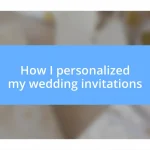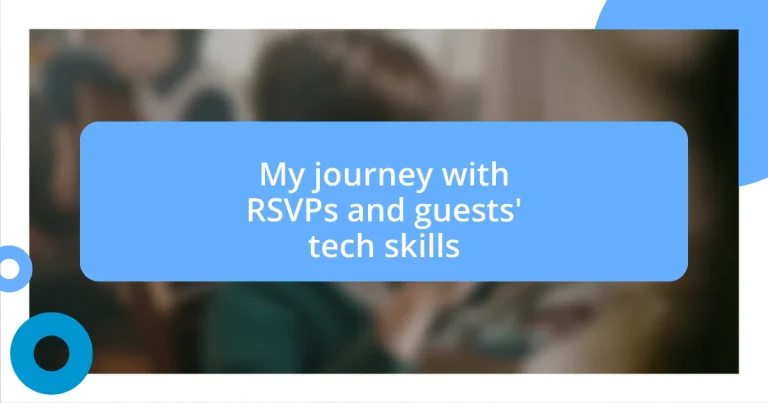Key takeaways:
- RSVPs are crucial for effective event planning, helping hosts manage attendance, seating, and catering while fostering respect and connection with guests.
- Utilizing technology for managing guest lists, including automated reminders and shared documents for dietary preferences, simplifies the organization and enhances the guest experience.
- Follow-up strategies, such as personalized reminders and using multiple communication channels, significantly improve response rates and encourage guest engagement before events.

Understanding the importance of RSVPs
RSVPs hold an essential place in event planning. They allow hosts to gauge attendance, ensuring everything from seating arrangements to catering can be managed effectively. I remember planning a surprise birthday party for a dear friend. I was overwhelmed with joy as guests RSVP’d, each response lifting the weight of uncertainty off my shoulders.
Have you ever felt the anxiety of not knowing how many will show up? It’s like casting a net into a sea of possibilities, hoping to reel in just the right number. In my experience, receiving a prompt RSVP can turn what might feel like chaos into a well-orchestrated gathering, leaving less room for last-minute scrambling.
Moreover, RSVPing is a form of respect for the host. It acknowledges their efforts and sets the tone for the event. When I host, I feel genuinely appreciated when guests take the time to respond. I sometimes wonder, how can we cultivate a culture where RSVPs are seen not just as a task but as a commitment to connection?

Creating effective RSVP templates
Creating effective RSVP templates can significantly enhance your event planning experience. Having a well-crafted template not only streamlines the process but also improves response rates. I once designed a simple yet appealing RSVP template for my sister’s wedding, and the delight it brought to our guests was palpable. The design was clean, with a warm invitation that made it easy for them to respond without feeling overwhelmed.
Here are some key elements to consider when creating your RSVP templates:
- Clarity: Ensure the event details, including date, time, and location, are easily visible. I often bold important information to catch the eye.
- Simplicity: Keep the response options straightforward, whether through a digital platform or paper. No one wants to navigate a quiz just to say ‘yes’ or ‘no.’
- Personal Touch: I like to incorporate a friendly note or a personal message to make guests feel valued. It can create an emotional connection right from the start.
- Deadline: Specify a clear deadline for responses. I learned that a polite nudge really helps in getting those last-minute confirmations.
- Follow-up: Include a note on how you’ll follow up. This reassures guests that their responses matter, as I learned from my experience when a gentle reminder boosted our reply rate immensely.

Engaging guests through digital platforms
Engaging guests through digital platforms is a transformative aspect of modern event planning. I love how technology allows me to interact with guests in more dynamic ways. For instance, I remember hosting a virtual gathering where I used a polling feature on the platform. It was thrilling to see real-time feedback on what snacks everyone wanted. It felt like we were truly part of the same experience, despite the distance.
Using vibrant social media platforms can also spark excitement around an event. I once created a dedicated event page on Facebook, and the buzz it generated was incredible. Guests shared their anticipation, exchanging ideas for fun activities, which I hadn’t even considered! This kind of engagement fosters a sense of community before the event even begins. It makes everyone feel included, creating a shared journey rather than a simple one-off occasion.
Additionally, I find that employing event-specific hashtags enhances that connection, facilitating seamless communication and memorable moments. During a family reunion I organized, guests posted photos with our unique hashtag, which allowed us to relive those beautiful moments together. It’s amazing how digital engagement can cultivate lasting bonds among people, often igniting conversations that continue long after the event ends.
| Engagement Strategy | Benefits |
|---|---|
| Live Polling | Interactive experience; instant feedback on preferences. |
| Social Media Pages | Build excitement; encourage community discussions. |
| Event Hashtags | Facilitate storytelling; create a shared memory archive. |

Managing guest lists with tech
Managing guest lists with tech has truly made my life easier, and I can’t emphasize that enough. I remember a time when I manually tracked RSVP’s in a spreadsheet, which was time-consuming and prone to errors. When I discovered event management software, everything changed. It was a bit like upgrading from a flip phone to a smartphone! I could effortlessly track guest responses in real time, and it provided a much clearer picture of attendance numbers.
Using an app or platform not only organizes the data but offers additional features that are surprisingly useful. For example, when I planned a friend’s birthday party, the platform I chose allowed me to send automatic reminders to guests who hadn’t responded. It was gratifying to see the responses flow in as soon as those nudges went out. Have you ever experienced that moment of relief when your guest list finally fills up?
Additionally, I found that creating a shared document where guests could mention their dietary preferences was invaluable. Imagine planning a dinner only to realize a guest is allergic to something common on the menu! This simple tech solution not only saved me from a potentially awkward situation but also helped guests feel cared for. In my experience, leveraging technology in managing guest lists transforms a somewhat overwhelming task into a seamless, enjoyable experience.

Follow-up strategies for RSVPs
One effective follow-up strategy that I’ve personally embraced is sending gentle reminders as the event date approaches. I recall an instance where I organized a community potluck; sending a friendly message a week prior really helped nudge those who hadn’t replied yet. It’s amazing what a little reminder can do, especially when paired with excitement about the upcoming gathering. Have you noticed how enthusiasm can transport even the most forgetful friends back into the RSVP loop?
Another tactic I’ve found valuable is the art of personalization in my follow-ups. Instead of a generic message, I like to reference specific details from our previous conversations. After hosting a game night, I remember texting a friend who was hesitant about their RSVP and mentioning how much I looked forward to their legendary nacho dip. Engaging them on a personal level not only often elicits a response but also builds on our friendship. Isn’t it magic how a small touch can transform a simple reminder into an invitation they can’t resist?
Finally, leveraging multiple communication channels can really enhance your follow-up effectiveness. I once invited guests for a summer BBQ and opted to send text messages alongside emails. The surprising result? My response rate skyrocketed! Some preferred the intimacy of a text, while others liked the formality of an email. It made me reflect on how vital it is to meet people where they’re most comfortable. Have you ever discovered that a single approach might not resonate with everyone? That’s a lesson I hold close!

Evaluating the success of RSVPs
Evaluating the success of RSVPs often boils down to analyzing response rates. I remember a time when I organized a small gathering, and I was pleasantly surprised by a 90% response rate. It felt rewarding to see people’s enthusiasm, but it also made me reflect on what contributed to that success. Was it the engaging invite I designed, or did my timely follow-ups play a role? These are the questions I think about whenever I tally up those responses.
Another key factor to consider is the quality of the responses. Were guests’ replies thoughtful, perhaps mentioning what they’d like to contribute or asking about the event? I hosted a casual brunch once, and one friend took the time to suggest a fun game we could all play. That not only showed their interest but also fostered a sense of community. These meaningful interactions make me realize that successful RSVPs are not just about numbers; they reflect engagement and excitement.
Ultimately, I’ve learned to assess the overall energy and atmosphere of the event itself as a measure of RSVP success. After all, it’s one thing to secure responses, but quite another to create an environment where everyone feels comfortable and engaged. At a recent family reunion, I noted how relaxed everyone was, and I felt proud knowing that my planning efforts led to this joyous occasion. Have you ever sensed that remarkable vibe after all the planning was done? That feedback—non-verbal yet powerful—tells me that my RSVP efforts were truly successful.














